
10 plants with flowers in umbels: the most beautiful varieties
Discover our selection
Contents
Umbels are flattened inflorescences bearing numerous small flowers. This is notably a characteristic of family Apiaceae, or Umbellifers. These inflorescences are very striking, and are most often white, sometimes pink-tinged, purplish (Angelica gigas), or yellow (Foeniculum). They have a very natural look, thanks to their light, airy appearance. They therefore fit well in naturalistic gardens, alongside other meadow flowers: yarrow, Gaura, Verbena bonariensis, Cosmos, cornflowers… Some of these Apiaceae are suited to shaded media, such as Angelica, Aegopodium podagraria, while others grow in full sun (Foeniculum…). These plants are sometimes scented, aromatic, and have culinary interest, such as fennel, chervil, angelica… However, be careful as some plants in this family are toxic. When in doubt, stick to ornamental use! To create beautiful borders, we recommend varying flowering forms in the garden: umbels, spikes, corymbs, heads, solitary flowers… ideal for breaking monotony!
Angelica
Angelica is a giant umbellifer, biennial or short-lived, prized for its spectacular flowering. The best known is Angelica officinalis, or Angelica archangelica, highly prized in pastry and confectionery, notably for its candied stems or for flavouring cakes and biscuits. It is an aromatic and medicinal plant. This large, architectural and imposing plant can reach over two metres tall! It also has large pale green leaves, divided into leaflets. It usually flowers in June–July, rarely in year of planting, rather in second or third year. Also discover Angelica gigas, notable for its beautiful deep purple colour. Regarding cultivation, Angelica prefers partial shade or non-scorching sun, in rich, cool, even moist soil.
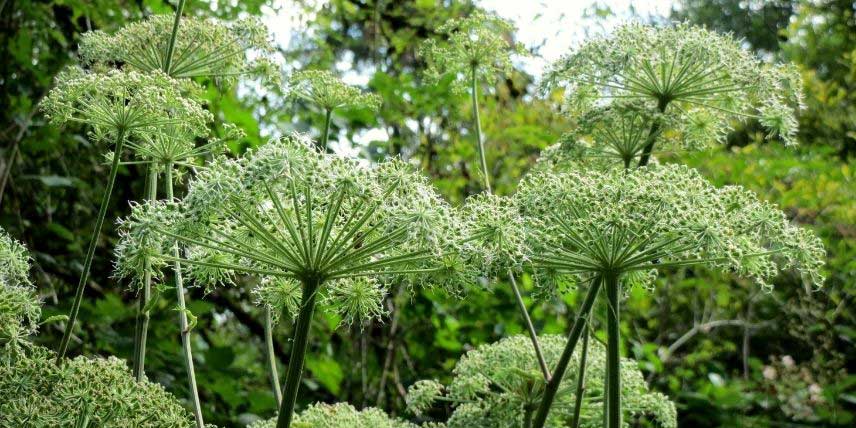
Imposing umbels of Angelica sylvestris
Pimpinella major
Pimpinella major, known as pimpinelle or greater burnet-saxifrage, is a superb Apiaceae perennial. We recommend Pimpinella major ‘Rosea’, which produces in summer, from May–June to July, very light, soft-pink flowering (unlike the type species, whose flowers are white). It also bears attractive dissected foliage, divided into dentate leaflets, and usually reaches between 40 cm and 90 cm in height. This plant prefers fresh, light, well-drained, rather calcareous soils. It grows in sun or partial shade. When happy in a spot, it tends to self-seed in the garden, without becoming invasive.
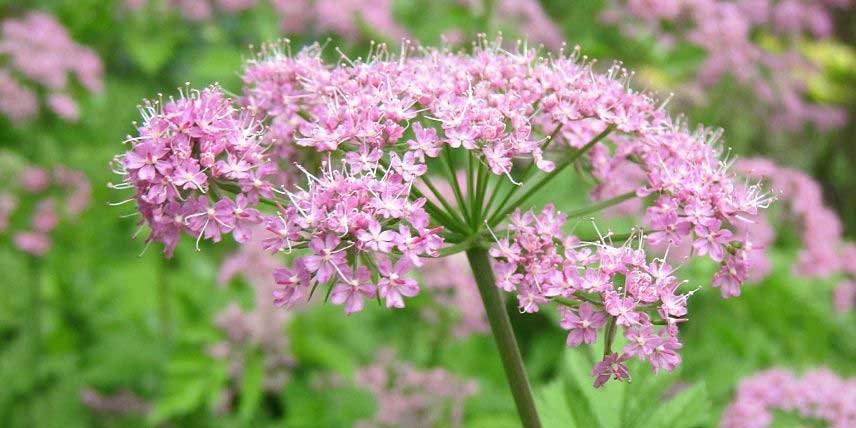
Soft-pink umbels of Pimpinella major ‘Rosea’
Discover other Perennials A to Z
View all →Available in 1 sizes
Available in 0 sizes
Available in 0 sizes
Available in 0 sizes
Available in 1 sizes
Available in 1 sizes
Available in 1 sizes
Available in 1 sizes
Available in 1 sizes
Available in 1 sizes
Daucus carota
Highly appreciated in vegetable gardens for its edible roots, carrot (Daucus carota) is also an ornamental young plant for its beautiful white, delicate and airy flowering! Moreover, its flowers are sometimes seen in the wild, in meadows, by path edges or in disturbed mediums. They are recognisable by their red spot at the centre of the inflorescence, and the bracts turned towards the ground. It is a biennial, and it flowers in the second year, from June to September. Its flowers are melliferous. It easily gives garden an air of wild meadow! We particularly recommend the ornamental carrot ‘Dara’, which produces flowers first deep purplish-red, then becoming pale pink and finally white.
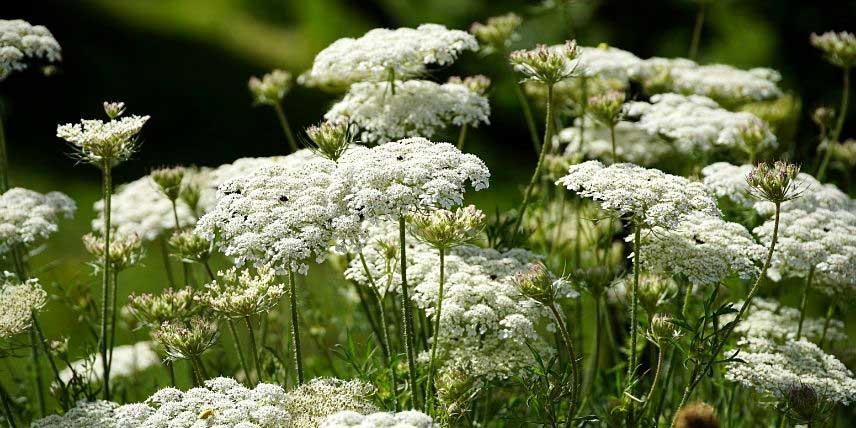
White, very delicate umbels of carrot, Daucus carota
Selinum wallichianum
Selinum wallichianum is a large umbellifer that bears cream-white umbels in summer, borne on bronze-purple stems, creating a lovely contrast! Umbels are first flat, then become fairly spherical. Its finely divided, pale green foliage is also much admired. Colour combination is splendid, between pale green leaves, purple stems and petioles, and cream-white flowers. An imposing plant, reaching 1.20 m in height… even up to 1.80 m in ideal conditions. Selinum wallichianum is certainly one of the most beautiful umbellifers. In the garden it prefers rich, moist soil and grows equally well in sun or partial shade.
Discover Ingrid’s article on our blog: “Selinum wallichianum, my favourite umbellifer”
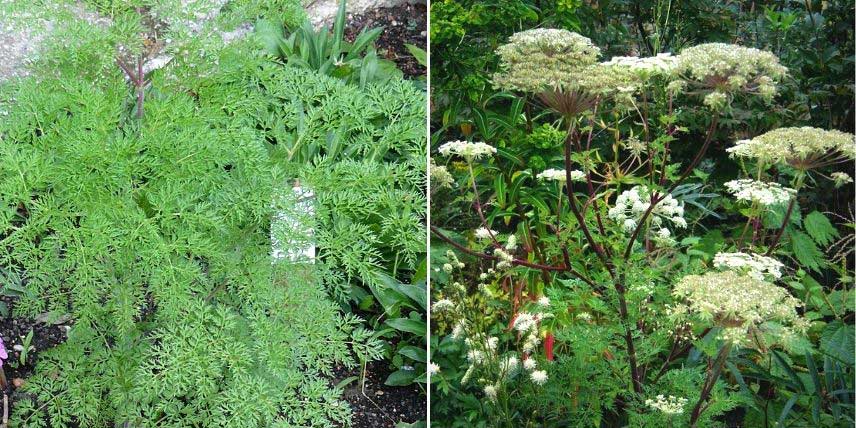
Finely divided foliage and white umbels of Selinum wallichianum (photos: Staudengärtnerei Forssman / peganum)
Anthriscus sylvestris
Anthriscus sylvestris, or wild chervil, is a biennial or perennial in the Apiaceae family that flowers from May to July and bears delicate white umbels. Its flowering has a vapoury, very airy appearance! Its delicately divided leaves are also much admired, somewhat like fern fronds. Wild chervil grows to between 60 cm and 1 m tall. We particularly recommend the variety Anthriscus sylvestris ‘Ravenswing’, which is notable for its very dark purple foliage… This creates a superb contrast with the white flowering! It fits easily into a naturalistic-style garden. Plant preferably in full sun, though it also tolerates partial shade, in good garden soil. When it is happy, it tends to self-seed!
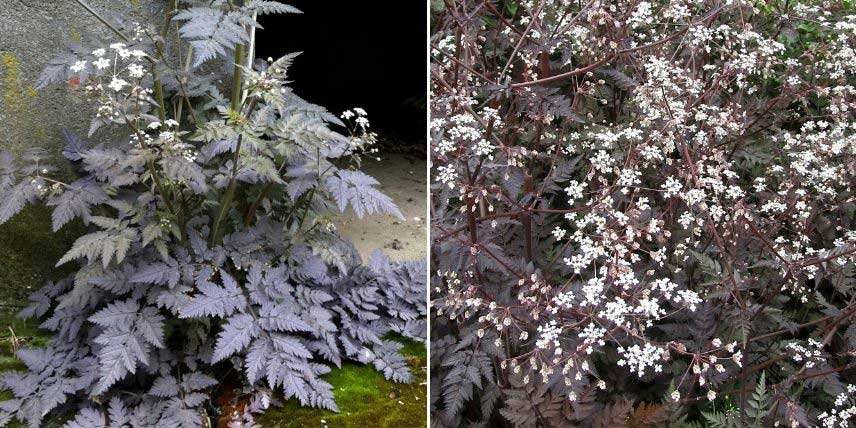
Foliage and very delicate flowering of Anthriscus sylvestris ‘Ravenswing’ (photos: Megan Hansen / Leonora Enking)
Foeniculum vulgare
Fennel is an Apiaceae generally perennial, sometimes biennial, which has very finely divided foliage, edible and aromatic, with an aniseed scent. It is fairly tall and can reach 1.50 to 2 m in height. Foliage has a vapourous appearance, like mist. In summer it bears yellow, very airy inflorescences, in the form of large, flat umbels. They are melliferous. It favours warm, sunny situations: plant in full sun, in well-drained, rather rich and light soil. It has excellent hardiness, and is also drought-tolerant. Discover also the splendid Bronze Fennel, which is distinguished by its coppery foliage.
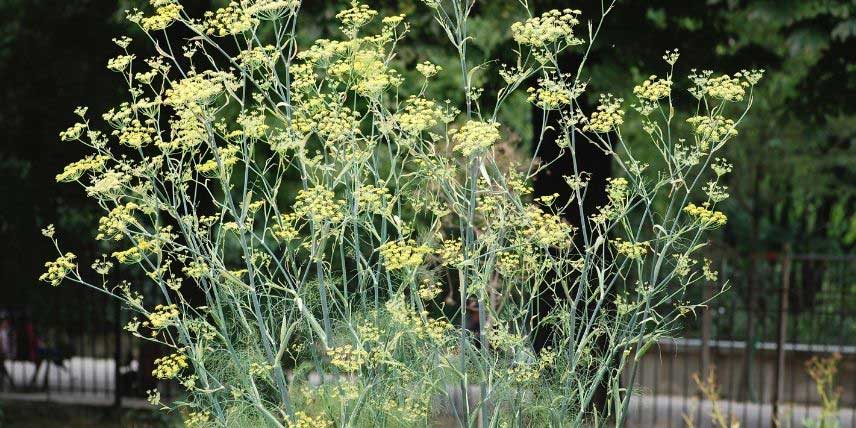
Yellow umbels of Fennel, Foeniculum vulgare (photo Alvesgaspar)
Ammi
Ammi is an annual plant that flowers in summer, generally from July to September, and then bears large, fairly dense white umbels, with a domed appearance. These are compound umbels: the large umbels are subdivided into smaller umbellules, which bear small five-petalled white flowers. They are melliferous and attract insects. The leaves are very light and airy, somewhat like those of fennel, and are blue-green in colour. Ammi thrives in sun or partial shade, and prefers clay, fertile, moist soils. It is sown in early spring and then requires no further care! It is hardy and not susceptible to diseases or pests… It is a plant with a very natural habit, which easily features in wild or cottage garden compositions, for example alongside ornamental grasses, Gaura lindheimeri, salvias, knautias, Verbena bonariensis… It is also perfect as a cut flower for arranging bouquets. There are two main cultivated species: Ammi majus and Ammi visnaga. We particularly recommend the variety Ammi visnaga ‘The Giant’.
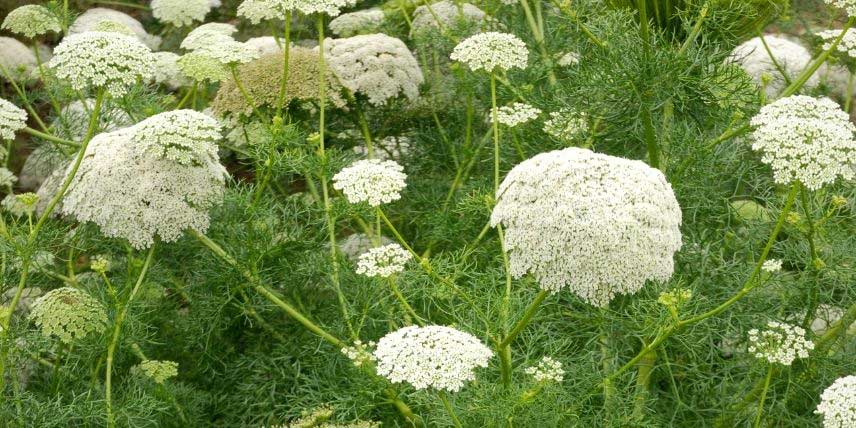
Large, fairly dense white umbels of Ammi visnaga
Aegopodium podagraria
Also called goutweed or bishop’s weed, Aegopodium podagraria is a rootstock-forming perennial groundcover that flowers from May to August, producing delicate white umbels. It also has leaves divided into three sections, often themselves further divided into three ovate, dentate lobes. Aegopodium podagraria occurs wild in France, in forest. Thus it prefers shaded positions and favours fertile, cool, even moist, preferably calcareous soil. It is a vigorous plant that grows quickly thanks to its running rootstock… Beware, as it tends to become invasive! When planting in garden, allow enough space around it and avoid planting other perennials nearby, as it may smother them. It is, however, perfect for dressing the base of trees. We recommend Aegopodium podagraria ‘Variegata’, which has green leaves marginate with white. It is ideal for bringing light into a woodland garden!
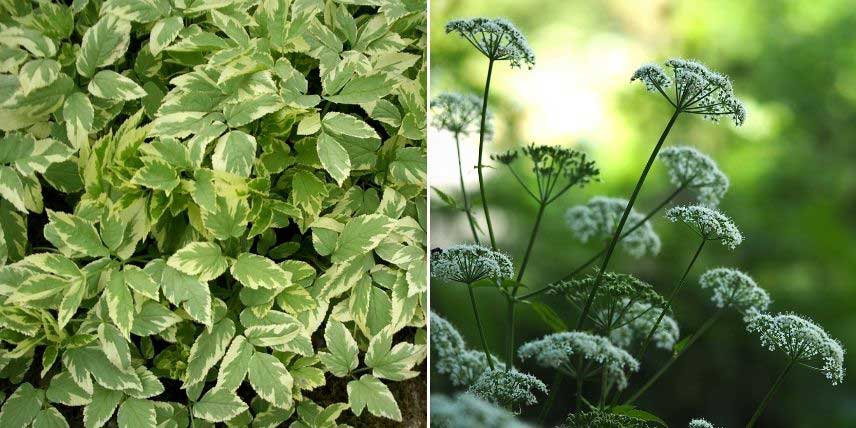
Variegated foliage and delicate flowering of Aegopodium podagraria ‘Variegata’
Myrrhis odorata (sweet cicely)
Sweet cicely, or Myrrhis odorata, is a handsome Apiaceae perennial valued for its splendid, very finely divided foliage, like fronds of ferns. Leaves are large, measuring up to 30 cm, and are deciduous. It flowers in late spring, in May-June, producing white umbels. It reaches up to 1 m in height. Entire plant gives off an aniseed scent… moreover its leaves and seeds are edible: they have a pleasant aniseed flavour and are used to flavour dishes. Sweet cicely thrives in partial shade, in rich, moist soil.
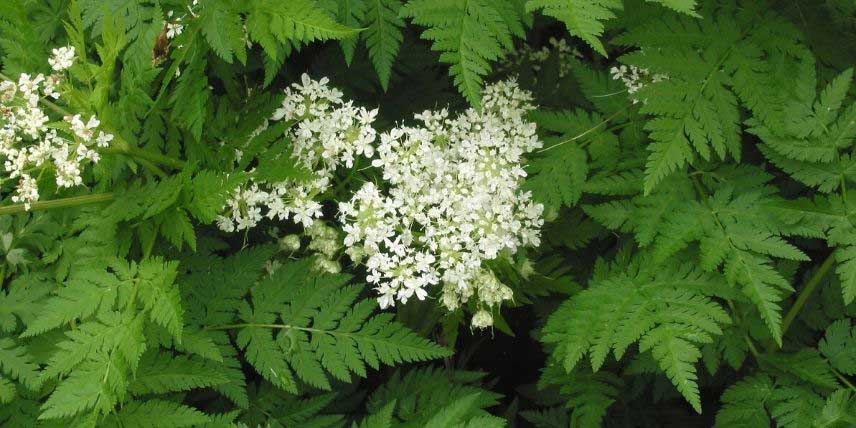
White flowering and finely divided foliage of sweet cicely, Myrrhis odorata (photo Rasbak)
Chaerophyllum hirsutum 'Roseum'
Chaerophyllum hirsutum ‘Roseum’, or hairy chervil, is a perennial Apiaceae that forms large ramified clumps and that bears in spring, in May–June, delicate pink umbels. They are 4 to 6 cm in diameter. Its flowering is melliferous and attracts pollinating insects. Leaves are finely divided and reminiscent of fern fronds. They release an apple scent when crushed! They are deciduous. It reaches 60 to 90 cm in height. With its delicate pink umbels, Chaerophyllum hirsutum ‘Roseum’ has a romantic yet wild, very natural look! Unfortunately, this plant is too little known and rarely grown! Chaerophyllum prefers partial shade, in fertile, moist to wet soil. Type species Chaerophyllum hirsutum, with white umbels, is found in the wild in French mountain massifs.
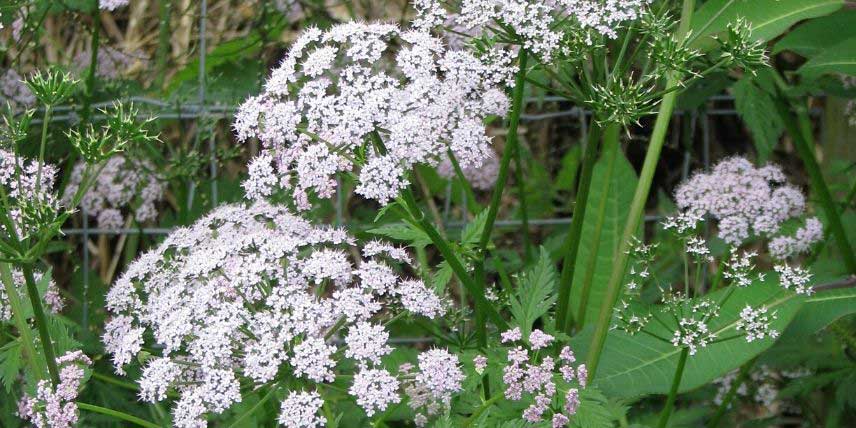
Soft pink umbels of hairy chervil, Chaerophyllum hirsutum ‘Roseum’ (photo peganum)
- Subscribe!
- Contents
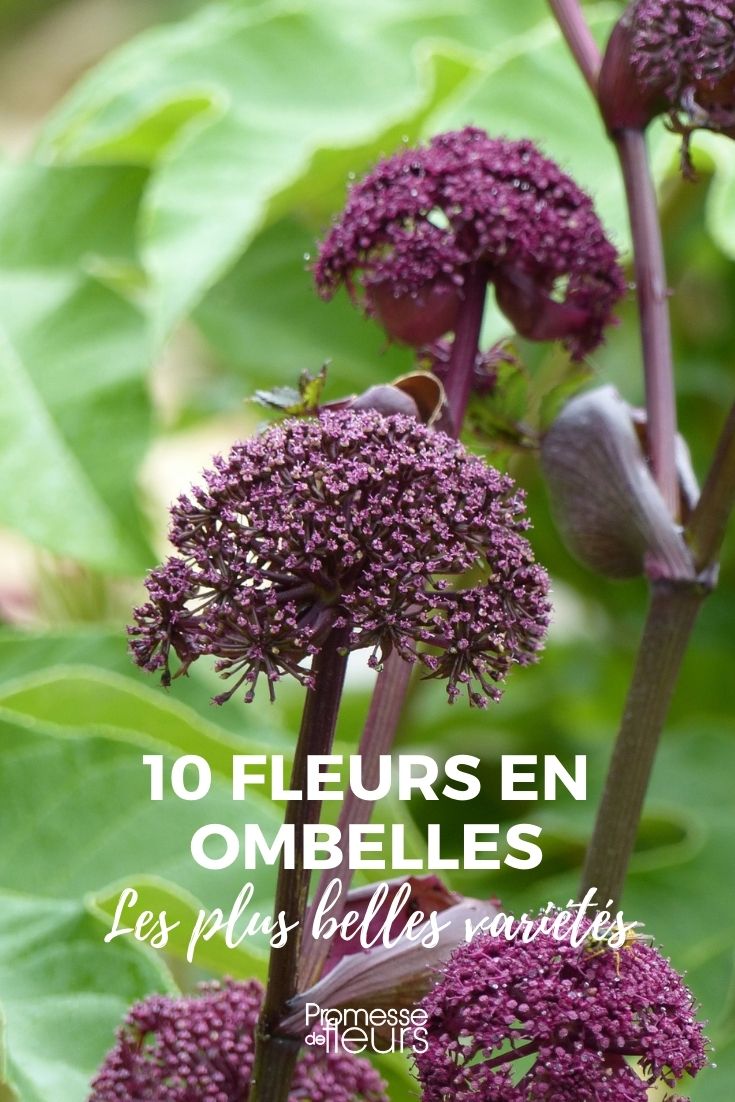































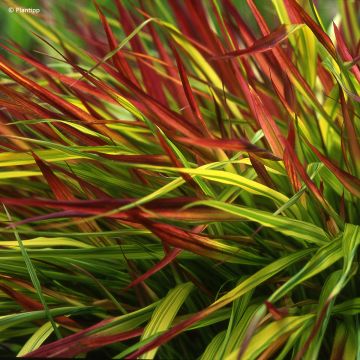
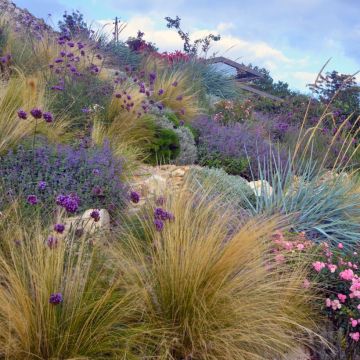
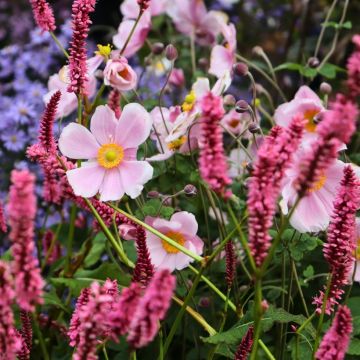

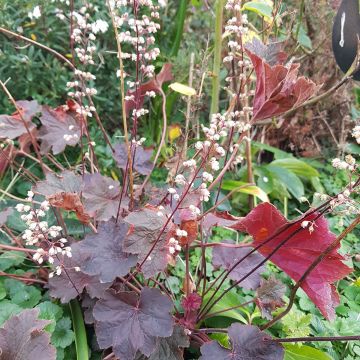
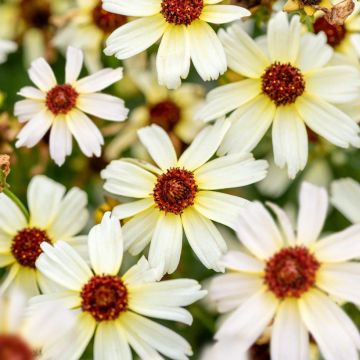
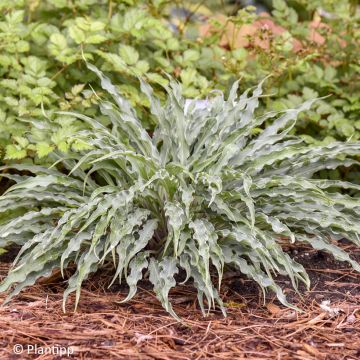
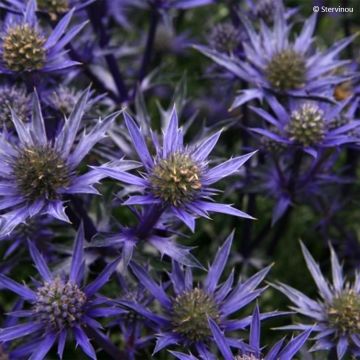
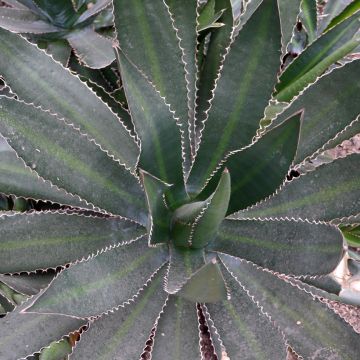

Comments